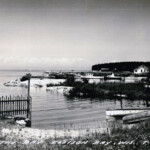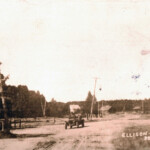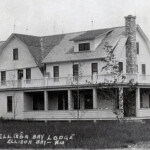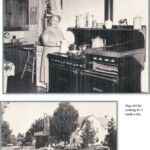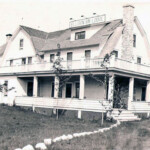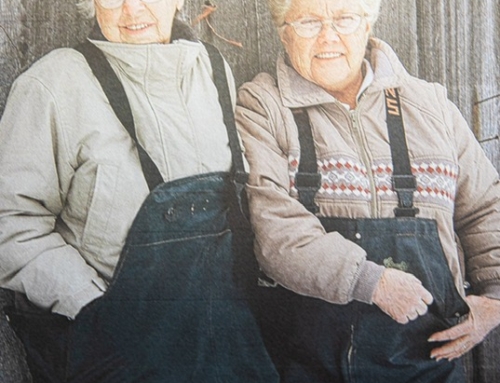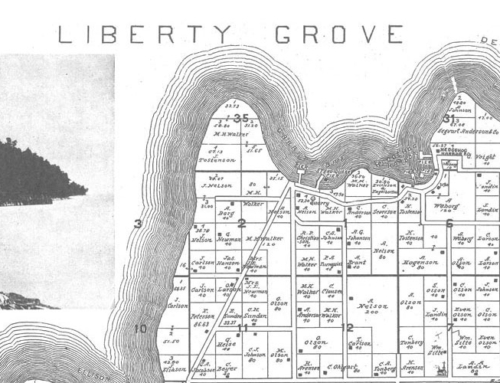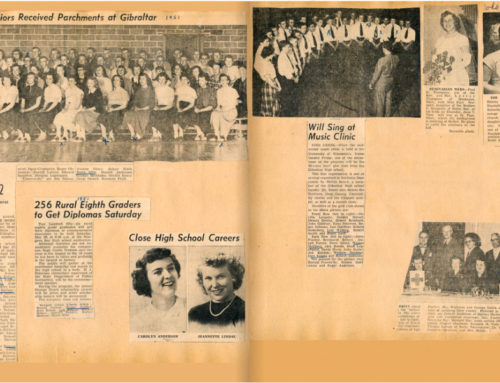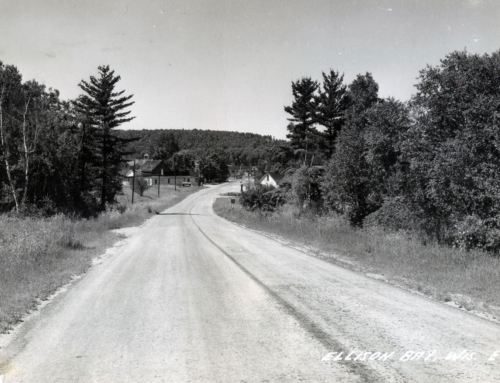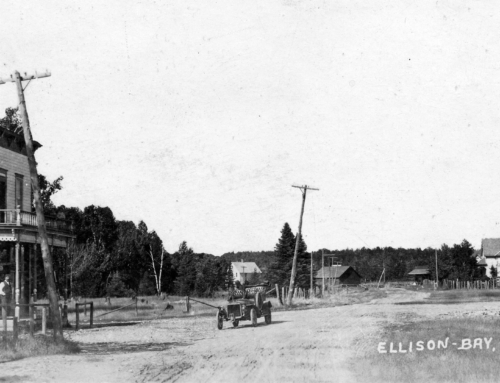By M. Marvin Lotz
Door County Almanak #5
Copyright 1990
The Griffin Inn in Ellison Bay can trace its beginning back to 1910 and the story of how it grew and developed is an interesting part of the always changing Door County scene.
As is the case with many of the original tourist accommodations on the peninsula, the Griffin Inn has grown in size and accommodations. At first it was called the Ellison Bay Lodge. That was changed to Griffin Inn later on. The earliest visitors, those who could be called “tourists” were escapees from the heat of the city… Some came to get relief from hay fever in the days before antihistamines. In those days, hay fever made breathing difficult and even brought on life-threatening conditions for its victims. It was not unusual to see a mother with a youngster with watering eyes in tow, alight at the Ellison Bay pier with a large steamer trunk filled with enough clothes for the entire summer.
Around the turn of the century, when the village was still walled in by tall trees, wood cutters were employed to turn them into lumber and get them on board ships. The men who did the work needed a place to live and the Ellison Bay Lodge provided them with housing and good food.
EARLY HOTELS
The northern tip of the Door Peninsula was, in some ways a separate entity from the rest of the county as late as the 1920’s. The village of Ellison Bay was a lumber shipping point established by John Ellison, the first permanent settler who became one of the largest land owners in the county. As transportation and accommodations improved, the trees thinned and tourists began to appear and seek out resort type housing. But there was a need for the short term visitor, namely, the traveling salesman. Most of the merchandise that filled the general store shelves was ordered through traveling salesmen. These men traveled from village to village on the steamers on a regular route two or three times each year. Their routes usually went from Sturgeon Bay to Egg Harbor to Fish Creek to Ephraim, Sister Bay and then to Ellison Bay. From there they went to Washington Island and beyond. The hotels depended on these men for much of their business. The same hotels welcomed doctors and dentists who came to villages on a regular schedule and a hotel room could double as an office and a place to stay. These men also traveled by boat although some, who were from nearby villages, came by horse and buggy.
The residents of Ellison Bay looked forward to these visits for anyone from outside brought news from other villages and a few new stories and jokes. This was especially true of the traveling salesmen.
ELLISON BAY LODGE
What had first been a house, built in 1910 by Charles and Amanda Anderson for their growing family, became the Ellison Bay Lodge in 1921. Gilbert and Olga Wickman enlarged the original home to its present size in 1921, and became the first innkeepers. They were to operate it for 40 years. It later became the Griffin Inn. The name Griffin is recognized by Door County people. For that was the name of a ship that disappeared some 300 years ago and one which divers are constantly seeking to find.
The Griffin was the first wooden sailing ship ever built and sailed on the Great Lakes. It was launched near Niagara Falls in the early 1860’s by the young, French explorer, Robert LaSalle. This young Frenchman had built a reputation as perhaps the outstanding explorer of the Great Lakes in those times. He sent his new ship to the Door Peninsula…with a crew of 32 aboard; some “saints” and some “sinners”. None had received any pay for at least a year.
Up to that time, LaSalles fortunes had not all been favorable. He was deeply in debt to the French government as a result of his earlier adventures. He had sent a company of men to Washington Island to trade with the Indians and to gather furs. They had been very successful and amassed a large quantity of high grade furs, enough to fill the Griffin. By delivering the ship load of furs to his French Governor in Montreal, he would not only pay off his debts but finance other explorations. He was looking for the elusive way to China.
But when the Griffin sailed away from Washington Island, dark storm clouds were gathering in the west. The Griffin would never be heard from again. Whether the ship was caught in a storm and lost or whether its crew scuttled the ship and ran off with the furs will never be known. The many claims of divers that they have found the ship have gone unsubstantiated. But such reports keep the memory of the Griffin alive and a part of the lore of the Peninsula. What eventually happened to the explorer LaSalle is yet another story; one that is of interest but too lengthy to relate here.
OVER THE ICE
The early settlers of this part of the peninsula did not look to the village of Sturgeon or Green Bay as the place to go for supplies. It was easier to go over the ice or, when there was no ice, by boat to Marinette or Menominee. There were few, if any, good roads. The land between Ephraim and Fish Creek was mostly swamp. Plum Bottom south of Egg Harbor could not be crossed without a row boat unless it was frozen over. In the winter months, the route over the ice to Marinette was the better way to go. In the coldest winters, some enterprising person would set up a half-way house that provided a rest stop. It usually consisted of a small building dragged across the ice providing a hot meal and food and water for the horses. It was not unusual to see a dozen or more such wagons crossing the bay between the peninsula and Marinette in a single day.
Spring brought the first steamers on their regular runs up the west shore, with stops at most of the villages. The first ship of the season attracted a happy crowd to the village pier to celebrate. From Ellison Bay, the steamers went on to Washington Island before they reversed their route back to Chicago. Goodrich and Hart were two of the better known steamship lines with long records of safety and comfort. There were several smaller boats that crossed the bay, serving the villages with a combination of freight and short line passenger service.
EARLY RESORT OWNERS
During the days when it was called the Ellison Bay Lodge the resort was owned and operated by the Wickman family. Typical of the times, Mrs. Wickman did all the cooking on a wood burning stove, baking all the pies, cakes and breads. They served three meals a day. In those times, there was no such thing as “lunch”. There were three square meals each day beginning with breakfast in the morning, dinner at noon and supper at 6 pm. All of the guests were served at the same time in family style. The dishwashing was all done by hand. The dining room was open to the public on Sunday noon when a complete chicken dinner was served for $1.50. The rooms had single beds and the rates were $2.00 per week. All of the laundry was done by the owners family using a wringer type washing machine and hung out on lines to dry.
In the 1920’s, the tourist season began in late June and ended Labor Day. Before the end of the decade a few people began coming back in October to see the fall colors.
Most of the guests came by car or by train as far as Sturgeon Bay, Manitowoc or Marinette. Those who got off at Manitowoc or Sturgeon Bay took a bus on to Ellison Bay. Those who chose to take a train to Marinette took one of the smaller boats across the bay. At first, the usual stay was 2 weeks. Some stayed a month and some for the entire summer. One family left their twelve year old daughter, who suffered with hay fever, with the Wickmans for the entire summer. Every evening the guests would gather for games and socializing in front of the blazing fireplace. Many became life-long friends. Sometimes, on a Sunday evening, guests and hosts motored to the Peninsula State Park for a picnic supper.
The new landscaping that was put around the lodge required many, many pails of water, carried by the family from the well to the young trees that today are magnificently mature. The lawn was mowed with a push mower. The entire family took turns supplying the power. Every winter Mr. Wickman went out on Ellison Bay and cut enough ice to fill the ice house which was located downhill from the house. He would cover the ice with sawdust until it was needed during the summer months. He dragged it up the incline to the inn, rinsed off the sawdust and filled the iceboxes that held the food for serving guests and the family. Some of the old iceboxes are still on the back porch of the now Griffin Inn kitchen. The girls of the family still have pleasant memories of playing in the mostly empty ice house in the late months of the summer when most of the ice had been used up.
THE VILLAGE
What used to be called Pfiels Bay View (later Claytons, and then Voights) was, in the 1920’s and 30’s the amusement and recreational center of the village where dances, basketball games, roller skating, medicine shows, home talent shows, plays and Fourth of July celebrations were held. Movies were shown on a regular schedule but the projector was powered by a generator that was not always reliable, so roller skating was the most popular activity and people came from miles around, including the other villages.
The kids of the village made the area around the pier their swimming place. The more daring boys considered diving off the roof of the warehouses as good sport. The harbor was home for commercial fishing boats and the pile driving rigs that were used for setting net stakes for the fish nets made ideal, if dangerous diving boards. In winter the ski hill attracted the best jumpers in the county. There were quite a few. There was little or no cross country skiing in those times.
The electric supply lines that ran up along the shorelines of the peninsula from Sturgeon Bay arrived in Ellison Bay in the mid 1920’s. The route went north along Lake Michigan to Valmy and Institute and then crossed the peninsula by way of Peninsula Center and then on northwest to Fish Creek. Branch lines fed power to Egg Harbor and another to Jacksonport. By 1928 the line reached Sister Bay and then north to the tip of the peninsula including Ellison Bay.
The installation of electric lines had been encouraged by the federal government, anxious to get dependable service to their lighthouses and navigational lights on the various islands including Plum, Washington and Rock Islands. They felt the need for brighter and more dependable lights and to reduce their cost of supervising them.
Telephone lines were strung the length of the peninsula at about the same time and reached Ellison Bay before the end of the 1930’s. A new underwater cable containing four lines was laid across Deaths Door in the summer of 1927 from mainland to Washington Island via Plum Island.
The Griffin Inn was the first place to have electricity in the village when the owners had a generator installed. There were large globe lights on each of 8 pillars out front illuminating the entrance and driveway. There was a large lighted sign on top of the inn that could be seen from the pier in the harbor. Years later, the globes gave way to large flower boxes filled with colorful summer blooms. And the sign was replaced with a more modest one.
INN KEEPERS OF THE 1980’s
The owners and inn keepers of today are different, yet much like those of the 1920’s. They work just about as hard, are dedicated to making their guests comfortable and happy, and work at building a loyal following.
But they are different in that many are young couples who have moved to Door County. They did not necessarily grow up here. They came to Door County by choice because they had a desire to live and work here and to raise their children in this very special environment. The current owners of the Griffin Inn, Laurie and Jim Roberts are a fine example of this new breed of entrepreneur. The Roberts were living a happy and satisfying life in a suburb of Milwaukee, when they had the opportunity to buy the Griffin Inn early in 1986. When the papers were signed and the moving van had loaded their furniture and left for Ellison Bay, the Roberts loaded the food for the first meals for their weekend guests into the trunk of their car and in the midst of a snow storm, drove with their two daughters and pet cats to Door County. They put the finishing touches on their first guest dinner in the kitchen of the Griffin Inn and served it as if they had been proprietors for years.
Since then they have added a great deal to the operation, upgrading the décor and furnishings and always presenting a warm and friendly welcome to their guests. Gourmet meals are a daily experience.
Many of the owners of similar inns and motels are young, yet experienced business people and managers who recognize the benefits of the Door Peninsula. The season gets loner every year and inns are a year around operation. The schools of the county provide excellent educational opportunities and any child old enough to work, can find as much employment as they want in the summer season.
The Peninsula is filled with tradition and interesting history going back as far as the days when Robert LaSalle and his ship the Griffin was loaded with valuable furs, only to become an unsolved legend.
And that same, warm fire burns in the Griffin Inn fireplace every evening and guests gather around to enjoy the hospitality that has been part of the Griffin Inn for nearly 80 years.





